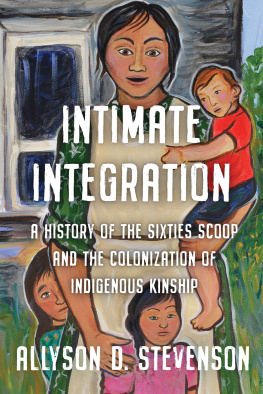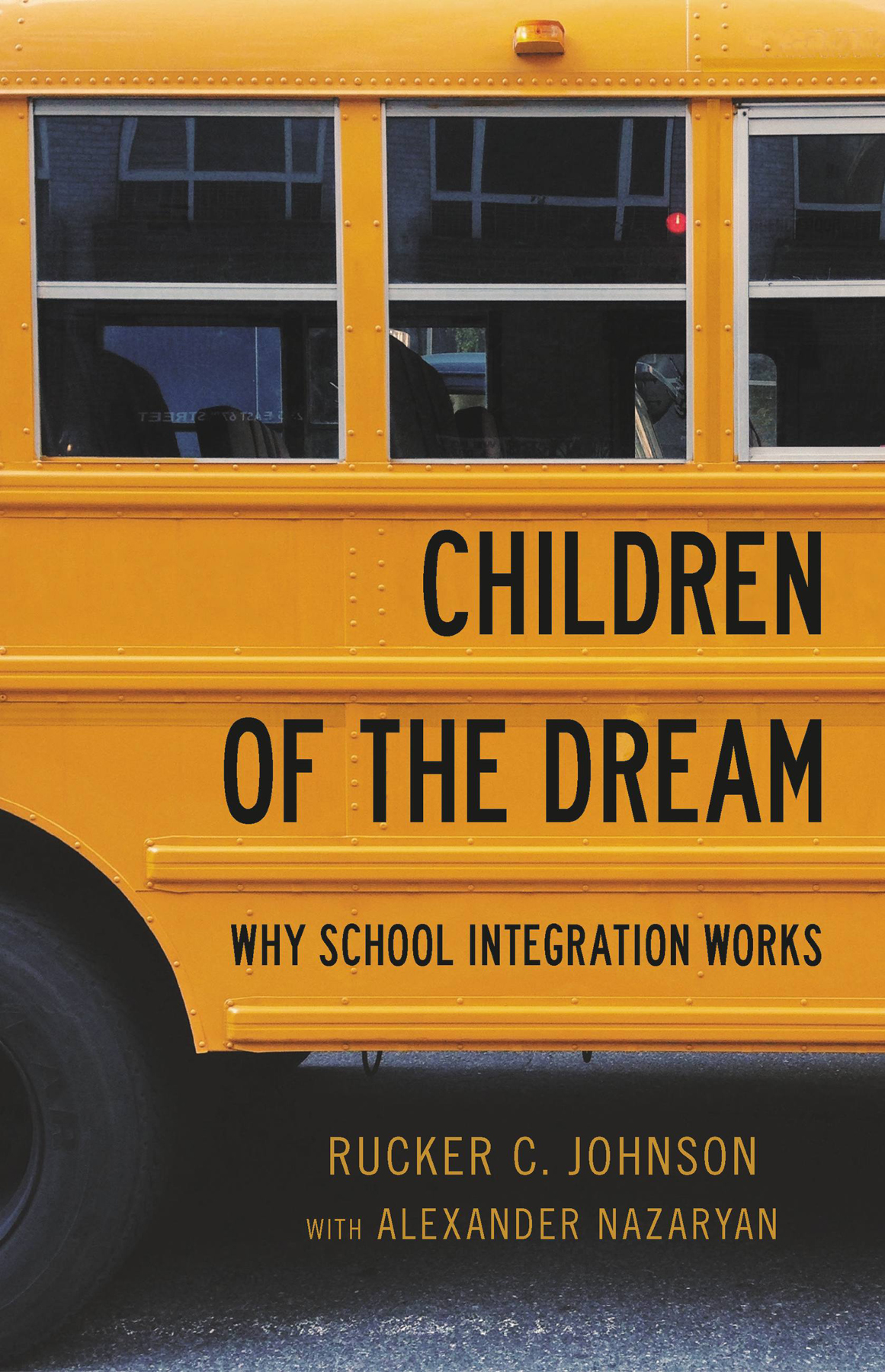Copyright 2019 by Rucker C. Johnson
Cover design by Ann Kirchner
Cover image copyright Andreina Velazquez/EyeEm/Getty Images
Cover copyright 2019 Hachette Book Group, Inc.
Hachette Book Group supports the right to free expression and the value of copyright. The purpose of copyright is to encourage writers and artists to produce the creative works that enrich our culture.
The scanning, uploading, and distribution of this book without permission is a theft of the authors intellectual property. If you would like permission to use material from the book (other than for review purposes), please contact permissions@hbgusa.com. Thank you for your support of the authors rights.
Basic Books
Hachette Book Group
1290 Avenue of the Americas, New York, NY 10104
www.basicbooks.com
First Edition: April 2019
Published by Basic Books, an imprint of Perseus Books, LLC, a subsidiary of Hachette Book Group, Inc. The Basic Books name and logo is a trademark of the Hachette Book Group.
Co-published by the Russell Sage Foundation
The Hachette Speakers Bureau provides a wide range of authors for speaking events. To find out more, go to www.hachettespeakersbureau.com or call (866) 376-6591.
The publisher is not responsible for websites (or their content) that are not owned by the publisher.
Graphics designed by Aaron Reeves
The Library of Congress has cataloged the hardcover edition as follows:
Names: Johnson, Rucker C., author. | Nazaryan, Alexander, author.
Title: Children of the dream : why school integration works / Rucker C. Johnson, with Alexander Nazaryan.
Description: First edition. | New York : Basic Books, [2019] | Co-published by the Russell Sage Foundation. | Includes bibliographical references and index.
Identifiers: LCCN 2018040106 (print) | LCCN 2018060898 (ebook) | ISBN 9781541672697 (ebook) | ISBN 9781541672703 (hardcover : alk. paper)
Subjects: LCSH: School integrationUnited States. | Segregation in educationUnited States. | Educational equalizationUnited States.
Classification: LCC LC214.2 (ebook) | LCC LC214.2 .J64 2019 (print) | DDC 379.2/630973dc23
LC record available at https://lccn.loc.gov/2018040106
ISBNs: 978-1-5416-7270-3 (hardcover), 978-1-5416-7269-7 (ebook)
E3-20190309-JV-NF-ORI
In loving memory of my Dad: my first history teacher
But my point was that not only I and my children are craving light, the entire colored race is craving light, and the only way to reach the light is to start our children together in their infancy and they come up together.
S ILAS H ARDRICK F LEMING, TESTIMONY IN B ROWN ET AL. V. B OARD OF E DUCATION OF T OPEKA , US D ISTRICT C OURT OF K ANSAS , 1951
AUTHORS NOTE:
RUCKER C. JOHNSON
I T HAPPENED THREE YEARS AGO. I WAS FORTY-TWO YEARS OLD, enjoying my life in the San Francisco Bay Area as an economist, professor, father, amateur musician, and fitness enthusiast. Everything was fine. Actually, everything was great.
One day, I felt a weight on my chest as I walked into the gym. Convinced that it was nothing but a little heartburn, I continued my workout. The pain didnt end, however. I told my wife that I would be okay if I got a good nights rest. But the next morning, she took my blood pressure and looked at me with shock. Based on the reading, I needed immediate medical intervention.
We sped to the emergency room. After excruciating hours of tests, the cardiologist confirmed that Id had a heart attack; he ordered an ambulance to rush me into emergency cardiac surgery.
I survived to complete this book with new attention to how bodily systems support each other and function interdependently. As I recovered, I considered my lifes work on poverty and inequality, specifically on the similarity between the human bodys systems and the policy systems of an equitable society. Through my research, I have come to terms with the reality that there is an undeniable interconnectedness among the policies designed to give our children (and their children) the opportunities they deserve to do something meaningful with their lives.
Just as our bodies begin to malfunction when systems fall out of balance, society suffers when we do not address inequality with the holistic strategy it deserves. I write this book as a health report on our nations goal of equal opportunity. I write to charge us individually and collectively to carefully consider the data analysis herein as evidence that we can have superior social outcomes when we design our education, health, housing, justice, and other policies to be connected from inception to implementationas well as through reformation.
We must tend to the health of those policies through an intentional, sustained effort. If we do it for our individual health, we certainly can do it for the health of the nation.
AUTHORS NOTE:
ALEXANDER NAZARYAN
B ECAUSE THE SCHOOLS ARE GOOD . T HAT WAS WHY MY PARENTS moved our family from Leningrad, in the Soviet Union, to the suburbs north of New York City. There were other reasons, too, that we didnt end up in Kansas or Oregon, but the quality of public education was foremost. In fact, it was a primary reason we moved to the United States instead of moving to Israel, where military service would await at the end of a high school career.
Nobody ever understands how lucky he is. So it was with me. It seemed normal, for example, that I had a full-time language teacher devoted to me and a small scrum of other Russian immigrants. The well-stocked classrooms, the well-compensated teachers, the newest textbooksthat was just how things worked. When my high school was named the sixtieth best in the nation, the news was met with widespread derision by the student body, because we were ungrateful in the way of all teenagers. Most of us had no clue that, just a few miles away, there were children attending schools unfit for the developing world, never mind for the wealthiest and most powerful nation on earth.
It was in high school that I started to understand the vagaries of public education. The way, for example, my own excellent schooling was funded by the wealthy families with enormous houses sequestered in the wooded hills above town. My own father, meanwhile, a PhD who had worked in a physics lab in the Soviet Union, delivered pizza. And there were the inner-city kids who were bused into our suburban enclave. They were the benefactors of a desegregation plan, though also the victims of long-standing racial inequalities. We didnt understand that, of course. Those kids, the black kids, stayed together, moving quietly through the hallways.
Later, after college, I became an educator, working in schools across Brooklyn, in large part to directly address the inequalities I had come to understand in the course of my own public education. This book is a continuation of that effort.
M ORE THAN SIXTY YEARS AGO, THE FEDERAL GOVERNMENT EMBARKED upon an experiment of astonishing ambition. It decided to reverse centuries of racism, discrimination, and forced separation of the races. The laboratory where this experiment took place is where we frequently test our grandest ideas about what American society should be: the public school classroom.
The experiment was called school integration, and it began with the 1954 Supreme Court decision in Brown v. Board of Education of Topeka, Kansas. The case has become such a mainstay of American culture that we tend to forget just how revolutionary it was for the nations highest court to decide that black and white children would no longer attend separate schools. And, whats more, that the federal government would exert its fullest power, including that of the military if need be, to end that separation.






